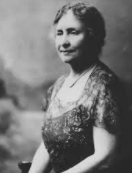Written by: Emily Vargo
March is National History Women’s Month. To kick off this month, I want to talk about one of my heroes. This amazing woman happens to have the same birthday as me, which is an amazing coincidence. This woman was born June 27, 1880, in Tuscumbia, Alabama. She would become an advocate for those with disabilities and prove many who doubted her wrong.
This amazing woman is Helen Keller.
At the young age of nineteen months old, Helen contracted an illness and became deaf and blind. Until age 7, Helen didn’t have much communication. She used more than 60 signs at home, and she would communicate with the cook’s daughter because the child understood Helen’s signs.
The Kellers wanted more for Helen and went to see Alexander Graham Bell. He advised them to contact Perkins Institute for the Blind, located in South Boston. The school asked Anne Sullivan, who was visually impaired, to become Helen’s instructor.
On March 5, 1887, Anne arrived at Keller’s house. Anne started signing letters in Helen’s hand right away. She first started with a doll that she bought for Helen as a gift. Helen became frustrated because she didn’t understand that every object has a name and meaning.
This is something that Helen wouldn’t understand until Anne made motions of letters on her hand while cold water was pouring on her palm. This is where she knows that water had a meaning and that all things had a word and meaning.
After this realization, Helen wanted to learn as much as she could. She begged Anne to teach her what everything was and meant. Even though Helen could not see nor hear, this did not mean she wasn’t in touch
with the world. She could understand music by feeling beats and vibrations. She had a connection with animals through her sense of touch.
Even though she could not hear, she would eventually find her voice and speak. In 1894, Helen and Anne moved to New York, and Helen attended Wright-Humanson school for the deaf. Then in 1896, Helen moved back to Massachusetts and went to the Cambridge School for Young Ladies until 1900, where she attended Radcliffe college of Havard University. Then in 1904, Helen graduated and was a proud member of Phi Beta Kappa. After college, Helen would learn to speak and give speeches to tell her story.
Helen and Anne were companions until Anne passed away in 1936. Then Polly Thomson was hired to be Helen’s companion, and they would be companions for the rest of Helen’s life.

Helen used her voice to advocate for those with disabilities and many other causes. She became quite involved in politics and was a member of the socialist party. She had radical views for the period, but she was never scared to share her ideas. Besides being educated and advocating for others, Helen wrote and published 12 books and several articles. One of Helen’s most famous books was her autobiography that she wrote at age 22.
The autobiography, The Story of My Life, was published in 1903 with the help of Anne and Anne’s husband. She visited many countries during Helen’s life and met countless famous people.
On September 14, 1964, President Lyndon B Johnson awarded Helen the Presidential Medal of Freedom. She received awards for her charity work for the blind and deaf throughout Helen’s life.
Helen passed away June 1, 1968, leaving an inspirational story for all to read and many more to look up to.
She also was an inspiration for me. Growing up, no one was like me. I didn’t know anyone who had a hearing impairment or eye issues. Learning about Helen and learning that we had the same birthday gave me someone to look up to and hope for the future.
Leave a Reply
You must be logged in to post a comment.